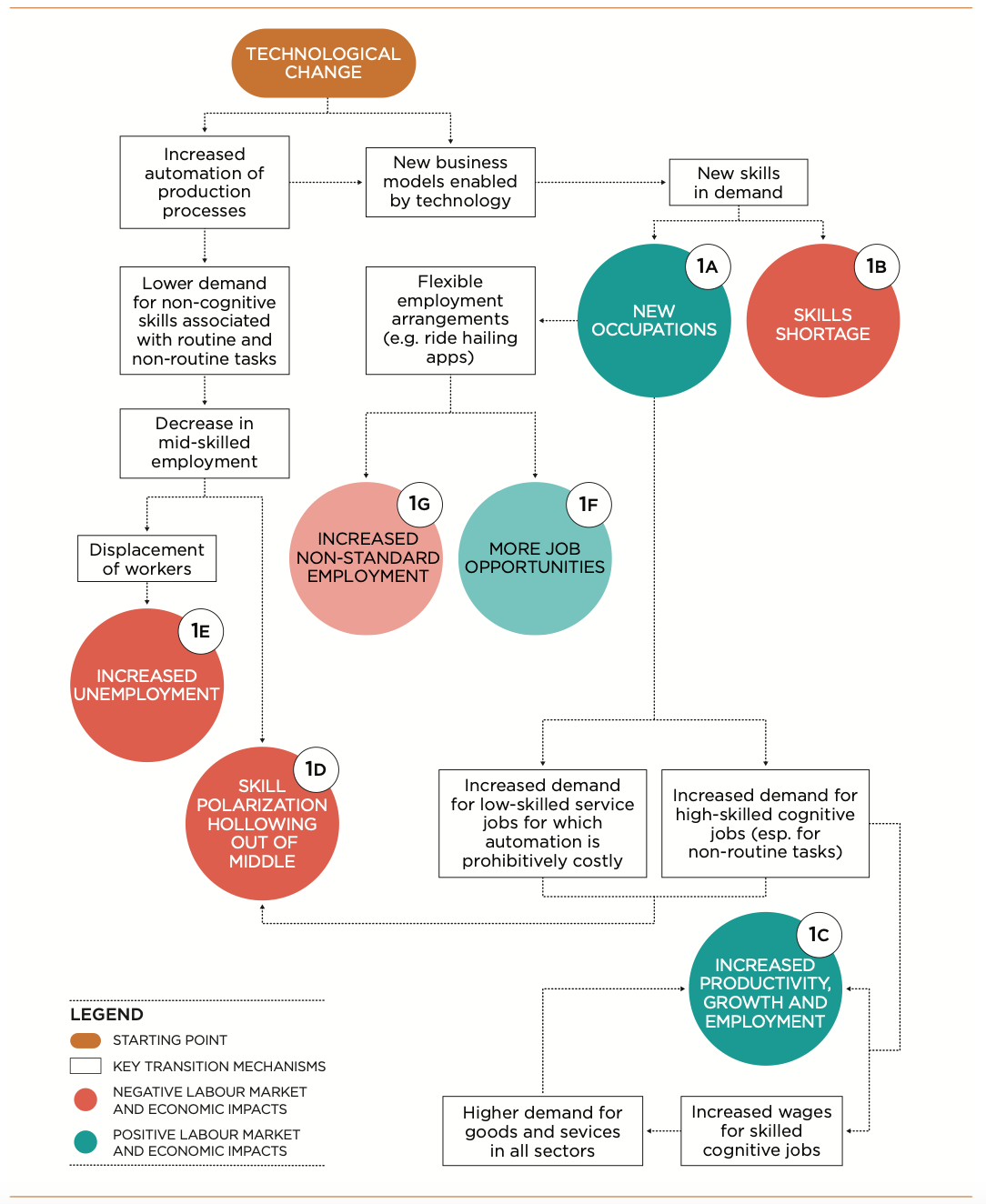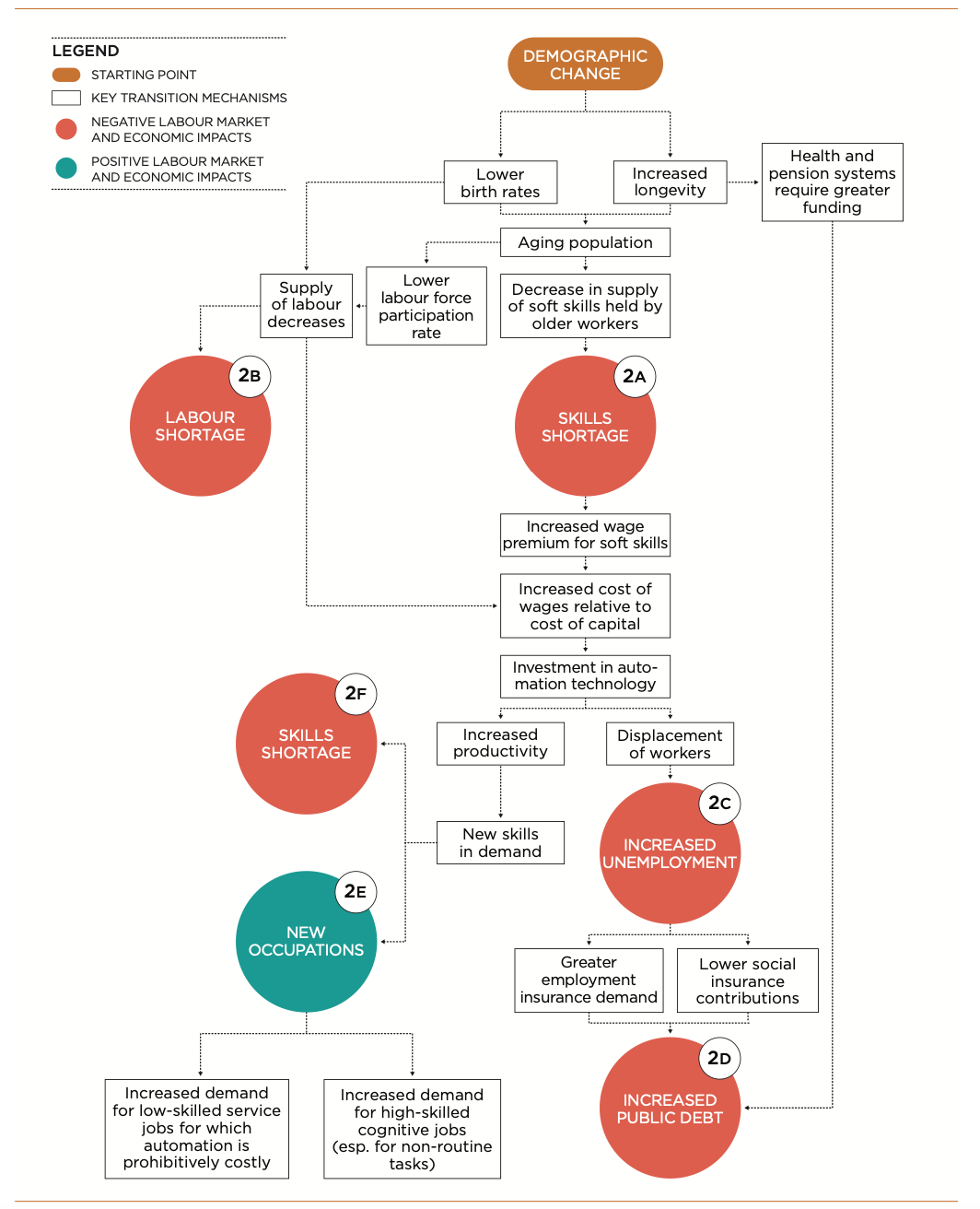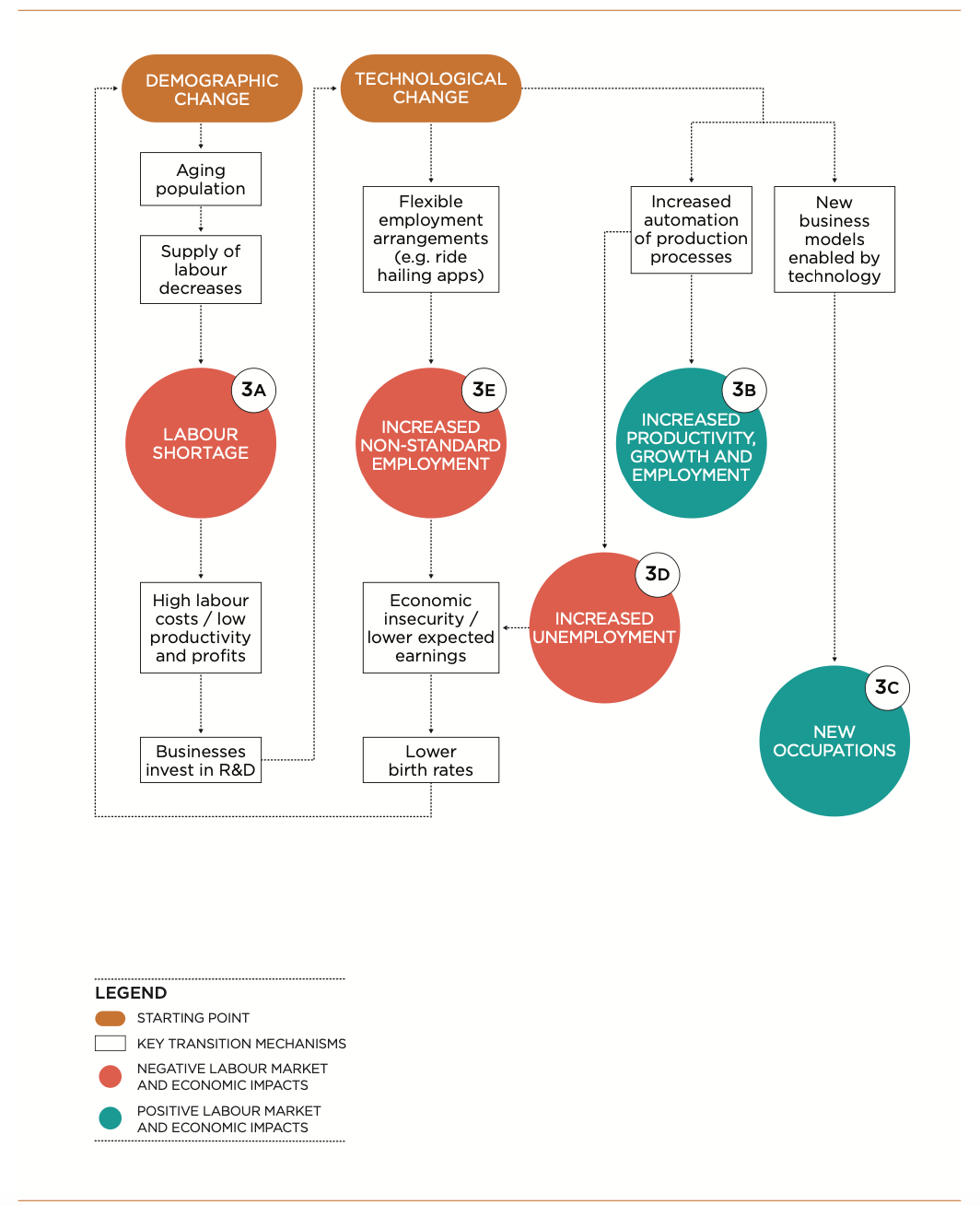Table of Contents
Key Findings
- Much of the debate about the future of work and its implications has been narrow in focus. This had led to potentially false or misinformed conclusions. One of the missing links in the future of work discussion, and related literature, is the interaction of megatrends.
- At LMIC, we recommend a systems approach that recognizes the interconnectedness of these trends and their joint implications for the labour market. For instance, by examining two of these megatrends together for illustrative purposes, i.e. evolution of technology and demography, we find the following:
- The impact of the aging population in Canada can decrease the skill supply, which can result in shortages and potentially higher wages. This can provide an incentive for firms to invest in automation to compensate for higher wages (offsetting the impacts of
population aging). - Technological change may place increased emphasis on soft skills, which can incentivize older workers with this skillset to postpone retirement (thus delaying the effects of populating aging).
- The impact of the aging population in Canada can decrease the skill supply, which can result in shortages and potentially higher wages. This can provide an incentive for firms to invest in automation to compensate for higher wages (offsetting the impacts of
- Moving forward, we will identify key LMI gaps in this area – an additional missing link – that are needed to better inform policy makers of the implications of the future of work.
Introduction
Concern about the impact of both long-term trends and sudden changes affecting the future of work has generated considerable discussion in both research and policy circles. To date, the bulk of this analysis has focused on new technologies including information technology, robotics and Artificial Intelligence (AI), and their impact on work. Yet, other trends such as climate, business model innovation and demographic change are also at play. As noted in LMI Insight Report no. 2, there is a persistent gap in the literature regarding the interactions of these megatrends due to both the complexity surrounding their potential joint outcomes and the lack of reliable data to measure them. LMI Insight Report no. 12 highlights the importance of a comprehensive systems framework for modelling the future of work.
This LMI Insight Report is a first step toward filling the gap on two interacting trends related to the future of work, demographic change and technological change. To shed more light on these interactions, we adopt a systems approach emphasizing the deep interconnections between the evolution of technology and demographic trends (see Future of Work Annotated Bibliography). Although the diagrams below are meant to be purely illustrative, they provide a simple and intuitive picture of the complex interactions between these two megatrends. Further, the systems approach helps identify persistent information gaps and clarify the various pathways through which these drivers will impact the future of work.
Technology and demographics: A review of potential impacts
Recent developments in automation technology have the potential to displace human labour, especially in routine-intensive tasks (Autor, Levy, & Murnane, 2003). However, by boosting productivity, such technologies can also induce further capital investments and economic growth. As a result, automation can lead to the creation of new tasks in which humans have a comparative advantage, while leading to displacement of workers in other areas.
It is common to hear technological change discussed, at least implicitly, as an independent force affecting the economy — that these changes are “pushed” by advancements in science. However, research and development are often driven — that is, “pulled” — by market demands. Godin and Lane (2013), among others, argue that this demand-pull view of innovation more accurately reflects patterns of technological change. In fact, they argue against viewing technological change as an exogenous force,1 and instead look at it as but one element in a larger system. Although a demand-pull view of technology is more realistic, it makes analyzing future trends and the impact on labour markets far more complex.
Our LMI Insight Report no. 2 notes that a major theme in the future of work revolves around questions discussing the substitution versus the complementarity of jobs and machines. There are two broad schools of thought here. In the first, large numbers of workers are at risk of being substituted by machines (e.g. Frey & Osborne, 2013). The second school of thought suggests that only a relatively small number of jobs will be entirely replaced. Instead of widespread layoffs, proponents of this view argue that the structure of jobs and tasks will be significantly influenced by technology (e.g. Lamb & Doyle, 2016). In this regard, David Ticoll (2019) suggests a comprehensive systems framework for modelling the future of work. The model would include labour substitution, changes to products and services, business models and industry ecosystems.
Demographic change is another important trend affecting labour markets in most countries, including Canada. The outsized Baby Boom generation has begun to retire, drastically increasing the ratio of inactive to working individuals. An aging population could reduce the total size of the workforce and the average skill level among workers. These demographic trends heighten the risk of widespread labour shortages and skills shortages, which lower productivity and can stall economic growth. Other potential challenges from the demographic shift include fiscal and social impacts such as strained finances for health and long-term care, as well as changing patterns of savings and consumption (see LMI Insight Report no. 2).
As with technological change, demographic shifts are also commonly viewed as purely exogenous. Yet, decisions around starting a family, for example, are strongly influenced by the health or distress of the labour market. Similarly, increasing longevity is the result of changing social preferences (e.g. healthier lifestyles) and new technology, which implies that even long-term demographic change is at least partially endogenous.
The trajectories of technological and demographic change interact with one another, and these interactions have important implications for the labour market, including unemployment levels, earnings growth, the creation of new occupations and alternative modes of employment. If left unchecked, these implications can heighten the risk of inequality and social polarization. Understanding these trends and their interactions is essential if policy makers are to develop effective responses to the challenges posed by the changing world of work. To that end, we explore an illustrative systems approach to assessing the interacting trajectories of technological and demographic change.
Flow diagrams: Making sense of the interactions
Using three flow diagrams, this section presents examples of interactions across the two key megatrends — technological change and demographic change — affecting the future of work. In Figure 1, technological change is considered as exogenous and in isolation from demographic change. In Figure 2, demographic change is considered independently. In Figure 3, the two trends are brought together to explore the interactions of their trajectories.
In the flow diagrams, three types of nodes are used:
- Oval nodes represent starting points: elements considered exogenous in the context of the diagram
- Square nodes represent key transition mechanisms
- Circular nodes indicate the main labour market and economic impacts
The distinction between transition mechanisms and impacts is not strictly defined; it mostly serves to focus the discussion. Note that the charts use different colours to emphasize positive (blue) and negative (pink) outcomes, with lighter colouring in cases where the outcome is more ambiguous.
Technological change
Figure 1 starts with disruptive technological changes that lead to the creation of new business models such as Airbnb. New business models can alter the volume and type of labour required, and the kinds of skills needed. As more and more new skills emerge, they eventually manifest as new occupations (1a), which will tend to be IT skill-intensive and non-routine. The figure emphasizes that in the absence of well-designed policy interventions, the demand for new skills and occupations might result in skills shortages (outcome 1b). If the demand for new skills is met, this will also increase productivity (see Bresnahan, Brynjolfsson, & Hitt, 1999), which should in turn lead to higher wages (outcome 1c).
Higher wages can act as employment multipliers in other sectors of the economy by generating higher demand for goods and personal services (Moretti, 2010). Personal services are usually provided by low-skilled workers performing nonroutine manual tasks that are difficult to automate. Therefore, as argued by Autor, Katz, and Kearney (2006), the boost in labour demand for high-skill employment due to technology, together with the increase in demand for low-skill workers in certain occupations, can result in labour market polarization as the top end and lower end of the labour market expand (outcome 1d).
In addition to increased demand for high- and low-skilled workers, the automation of production processes is likely to decrease demand for mid-skilled workers. This is because mid-skill occupations in goods-producing sectors are typically routine-intensive and thus easier to automate (Autor, Levy, & Murnane, 2001). Evidently, a decline in demand for routine occupations will lead to greater unemployment levels (outcome 1e). In such circumstances, reskilling programs can be used to retrain displaced workers who were previously performing routine tasks, helping to direct them toward higher paying occupations and avoiding prolonged bouts of unemployment.
Some of the jobs created by new technology will take the form of flexible employment arrangements (e.g. on-demand jobs), such as ride-sharing drivers or delivery services. While the quality of such work is likely to widely vary, these new employment arrangements should increase the overall set of job opportunities (outcome 1f). In fact, labelling on-demand work as positive or negative is challenging because research on the topic is still in its infancy and it has emphasized both aspects (De Stefano, 2015). On the negative side, flexible work arrangements might result in precarious employment, characterized by limited benefits such as health insurance, retirement contributions and short-term contracts (outcome 1g).
Figure 1: Flow diagram of technological change as if it were exogenous and isolated from demographic change.

Demographic trends
In Figure 2, demographic trends are treated as exogenous. Increased longevity and lower birth rates result in an aging population, which, in turn, has two main effects: 1) a decrease in labour force participation and labour supply; and 2) a decrease in the supply of “soft” skills,2 typically developed over a long period through direct work experience. In the absence of a well-designed policy intervention, these trends might result in a shortage of soft skills and/or labour shortages (outcomes 2a and 2b). A possible policy tool that can mitigate these outcomes is targeted immigration policies that help ensure a sustainable inflow of skilled workers from countries in which populations are growing.
At the other end of the age spectrum, younger individuals tend to have greater IT-related skills (OECD, 2014), and a scarcity of young workers is likely to increase the IT-skills wage premium. However, the increased wage premium for IT skills might not be enough to attract the employment required by firms due, for instance, to high mobility barriers across local labour markets (Moretti, 2010). In such cases, demographic trends might be responsible for the creation of skill shortages in the labour market (outcome 2f).
If either a labour or skills shortage occurs, the result will be an increase in the cost of labour relative to capital, which provides additional incentives for firms to invest in automation to reduce costs. This, in turn, can lead to worker displacement and an increase in unemployment (outcome 2c). Fewer people working implies lower contributions to social programs such as Employment Insurance, which could lead to cuts in such programs. Yet, in this scenario, the need for public funds allocated to health and pensions is increasing because of the primary driver: an aging population. Lower government revenue plus greater demand on social systems will likely lead to increased public debt levels (outcome 2d).
However, as in Figure 1, automation can also have a positive impact on the labour markets through the creation of new occupations (outcome 2e). If the job creation impact of automation outweighs its negative impact on labour supply, then the net effect of aging on employment and productivity might be positive (Acemoglu & Restrepo, 2017; 2018). The magnitude and balance of these competing forces is unclear and, as discussed below, will be affected by the interaction of other drivers of change.
Figure 2: Flow diagram of demographic change as if it were independent of technological change.

Drawing out the interconnectedness of technology and demography
Finally, Figure 3 combines the demographic and technological trends discussed above. Both drivers are usually considered exogenous, but here they are treated, at least partially, as both endogenous and interconnected. The grey squares in the centre of the figure display the two megatrends. The illustrative analysis suggests that the interactions of these two trends will tend to exacerbate both the positive and negative outcomes predicted above.
Starting with demographic change, the impact of the aging population results in a decrease in labour supply and a decrease in the supply of skills. The lower supply of workers results in labour and skill shortages (outcome 3a). As demand for workers and skills exceeds supply, the cost of hiring skilled workers increases, which translates into lower productivity and lower profitability. In such adverse conditions, firms face incentives to invest in research and development for new technologies to overcome the labour and skill shortages. Thus, the end of demographic change is to increase the magnitude and/or speed of technological change.
Starting now from technological change, the shift towards more automated production processes and the creation of new business models increases productivity (3b) and creates new occupations(3c). As in Figure 1, automation can displace workers and result in higher unemployment (3d). However, the incentives to automate are reinforced by the outcomes of demographic change illustrated in the top half of Figure 3. Further, the economic insecurity due to lower expected earnings and worsening employment prospects can result in lower birth rates (Adsera, 2004; 2005). Thus, the end of technological change is to increase the magnitude and/or speed of demographic change.
In other instances, technological change may slow or mitigate the impacts of demographic change. For example, if there is an increased emphasis on soft skills that emerge because of new technologies, some older workers might postpone retirement given the incentive of higher wages for their skillset. Thus, the end of technological change is a decrease in the magnitude and/ or speed of demographic change. Similarly, demographic change can have an impact on the pace and type of technological adoption.
In sum, the circular nature of the schematic in Figure 3 means there is no natural start or end point. The megatrend interactions illustrated here are mutually reinforcing in nature, suggesting an unstable dynamic system. However, the degree to which this system slows to a kind of steady state cannot be determined through this basic, illustrative example. What is clear is that demographic and technological trends are entwined and need to be considered jointly.
Figure 3: Technological change plus demographic change combined to explore their interactions.

The Way Forward
By looking at two megatrends — demographic change and technological change — this LMI Insight Report emphasizes the deep interconnections at play across the drivers of change. In doing so, it highlights the limitations of many of the studies we have reviewed and documented in our Future of Work Annotated Bibliography. Most studies examine one driver in isolation and therefore paints a partial and flawed picture of how the world of work is changing and how it could change.
Adopting a systems approach offers researchers and policy makers a shared understanding of different possible scenarios and their implications for the future of work. Of course, the complexity of the interactions, as emphasized in this report, suggests that it is not an easy task. However, these interactions should be borne in mind, even if only conceptually, in any meaningful discussions about the future of work. At the same time, one gap hampering our ability to assess the complex future of work is the absence of high-quality labour market information on topics such as skills and vacancies. This is especially true at the local and granular level, as outlined in our blog “Balancing Act: Considering Trade-Offs for Improving LMI.”
We are working with our partners to close gaps in key labour market information areas, such as skills (LMI Insight Report no. 16). Looking ahead, a forthcoming LMI Insight Report will identify specific gaps in labour market information that hamper our understanding of the linkages outlined in this report.
Acknowledgements
This LMI Insight Report was prepared by Giorgio Presidente from the Paris School of Economics, with support from LMIC staff.
We would like to thank LMIC’s federal, provincial and territorial partners, as well as our National Stakeholder Advisory Panel and Labour Market Information Experts Panel for their comments and suggestions. In particular, the team acknowledges the valuable input of Sandip Basi, Helen Cranley, Vicky Kianksy and Naomi Pope. We also thank Upeksha Amarasinghe and Asa Motha-Pollock (MaRS), Charlie Carter (Public Policy Forum), Sareena Hopkins (CCDF), Audrey Murray (Commission des partenaires du marché du travail) and David Ticoll (Chair, LMIC National Stakeholder Advisory Panel, and Professor, Munk School of Global Affairs, University of Toronto).
For more information about this LMI Insight Report or other LMIC activities, please contact Behnoush Amery, Senior Economist, at behnoush.amery@lmic-cimt.ca or Tony Bonen, Director, Research and Analytics, at tony.bonen@lmic-cimt.ca.
References
Acemoglu, D., & Restrepo, P. (2018). Demographics and automation. No. w24421. Cambridge, MA: National Bureau of Economic Research.
Acemoglu, D., & Restrepo, P. (2017). Secular stagnation? The effect of aging on economic growth in the age of automation. American Economic Review, 107(5), 174–179.
Acemoglu, D., & Autor, D. (2011). Skills, tasks and technologies: Implications for employment and earnings. In D. Card & O. Ashenfelter (Eds.), Handbook of Labour Economics, vol. 4, part B (pp. 1043–1171). Amsterdam: Elsevier. doi:10.1016/S0169-7218(11)02410-5
Adsera, A. (2005). Vanishing children: From high unemployment to low fertility in developed countries. American Economic Review, 95(2), 189–193.
Adsera, A. (2004). Changing fertility rates in developed countries: The impact of labour market institutions. Journal of Population Economics, 17(1), 17–43.
Autor, D. H., Levy, F., & Murnane, R. J. (2001). The skill content of recent technological change: An empirical exploration. The Quarterly Journal of Economics, 118(4), 1279–1333.
Autor, D. H., Katz, L. F., & Kearney, M. S. (2006). The polarization of the US labor market. American Economic Review, 96(2), 189–194.
Bresnahan, T. F., Brynjolfsson, E., & Hitt, L. M. (1999). Information technology, workplace organization, and the demand for skilled labour: Firm-level evidence. The Quarterly Journal of Economics, 117(1), 339–376.
Ticoll, D. (2019). Toward a systems framework for technology and the future of work. LMI Insight Report no. 12. Ottawa, ON: Labour Market Information Council. https://lmic-cimt.ca/wp-content/uploads/2019/04/LMI-Insights-No-12.pdf
De Stefano, V. (2015). The rise of the just-in-time workforce: On-demand work, crowdwork, and labour protection in the gig-economy. Comparative Labor Law & Policy Journal, 37, 471.
Frey, C. B., & Osborne, M. A. (2013). The future of employment: How susceptible are jobs to computerisation? Retrieved from https://www.oxfordmartin.ox.ac.uk/downloads/academic/The_Future_of_Employment.pdf
Godin, B., & Lane, J. P. (2013). Pushes and pulls: Hi(s)tory of the demand pull model of innovation. Science, Technology, & Human Values, 38(5), 621–654.
Kustec, S. (2012). The role of migrant labour supply in the Canadian labour market. Ottawa, ON: Citizenship and Immigration Canada.
Lamb, C. P., & Doyle, S. (2016). The talented Mr. Robot: The impact of automation on Canada’s workforce. Toronto, ON: Brookfield Institute for Innovation and Entrepreneurship.
Moretti, E. (2010). Local multipliers. American Economic Review, 100(2), 373–377.
OECD. (2014). Skills and jobs in the internet economy. OECD Digital Economy Papers No. 242. Paris: OECD Publishing. doi:10.1787/5jxvbrjm9bns-en
End Notes
- Exogeneity is a technical term in economics. An exogenous factor is one that changes independently of the system or relationship being modelled.
- Soft skills refer loosely to social, emotional and interpersonal knowledge. Examples include oral communication, effective leadership, persuasion and negotiation skills.


